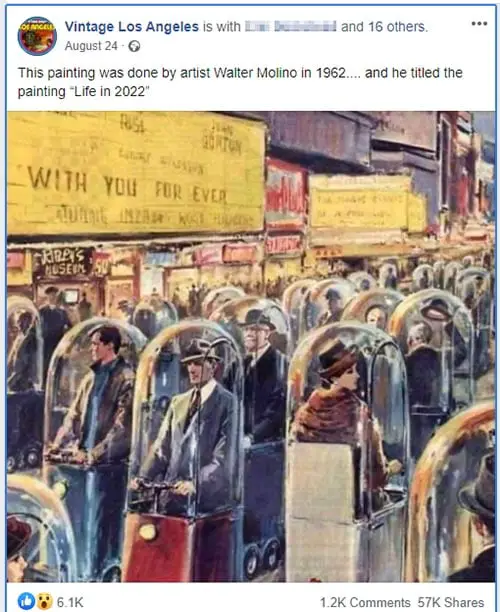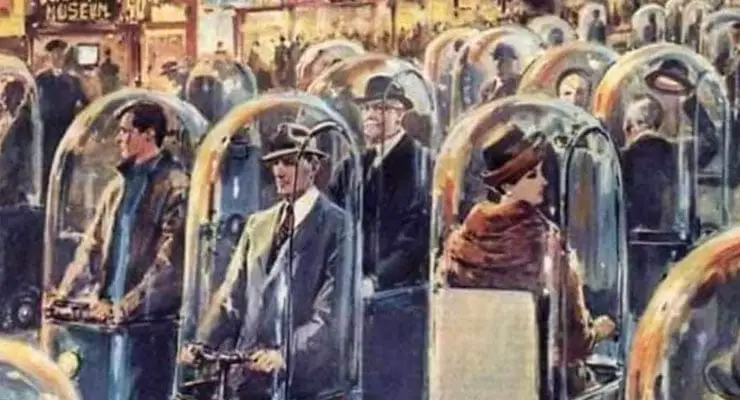Does 1960s artwork with protective bubbles predict life in 2022? Fact Check
Claims on social media purport to show a painting created during the 1960s showing people on the street inside protective bubbles, along with the claim that this was the artist’s prediction of life in 2022. Later variants of the rumour also assert the title of the painting is “Life in 2022”.
 MISLEADING
MISLEADING
Examples of the rumour are below.

In 1962, an Italian magazine carried a story on how the world will look in 2022.
– collected May 2020
This picture was painted in 1962 by Walter Molino and has the title: LIFE IN 2022
– collected September 2020
The image is circulating in 2020 to the backdrop of the COVID-19 pandemic. The rumours above appear to imply that this is an impressive prediction from the 1960s that predicts the pandemic and the resulting social distancing restrictions.
The artwork first circulated social media with the assertion that the artwork illustrated life in 2022. Subsequent rumours then stated that the artwork was in fact titled Life in 2022.
However the implications of these rumours are perhaps rather embellished. Firstly, there is nothing to suggest the painting predicted life in 2022 (and no, it’s not called “Life in 2022”) and secondly, the “bubbles” depicted in the artwork have nothing to do with social distancing or a pandemic.
Sponsored Content. Continued below...
What is true is that the artwork really is from 1962, and was created by artist Walter Molino, and it really did appear in an Italian magazine at that time, specifically the Domenica Del Corriere. However that is the extent of the accuracy of these rumours.
There is nothing we could find to suggest the painting reflected life during any specific year, much less the year 2022. Rather it appears to be an illustration of life in an undefined year in the infinite future.
And perhaps most notably, to rule out any likelihood of impressive predictions, the “social distancing bubbles” illustrated in the artwork actually have nothing to do with social distancing. That’s because the artwork is attached to an article about the “singolette”, a futuristic concept of a Segway, enclosed in a glass “bubble” weather-proof windscreen, that would help alleviate traffic caused by cars on the road.
Sponsored Content. Continued below...
The caption on the artwork is roughly translated as –
Will we go around town like this?
This is how the problem in the cities could be lightened, if not completely solved: instead of the current cluttered cars, tiny single-seater cars that occupy a minimum surface area could be introduced.
Walter Molino here imagined the appearance of the same street as the first table if the new solution were adopted on a large scale.
As such, if the artwork and accompanying article predicted anything, it’s the continued increase in frustrating rush hour traffic. But certainly nothing to do with a pandemic or a life influenced by social distancing restrictions.
While the artwork, artist and year of publication are all genuine, any implications or assertions that this is in any way some sort of prediction to the current COVID-19 situation are misleading.
Continued below...
Thanks for reading, we hope this article helped, but before you leave us for greener pastures, please help us out.
We're hoping to be totally ad-free by 2025 - after all, no one likes online adverts, and all they do is get in the way and slow everything down. But of course we still have fees and costs to pay, so please, please consider becoming a Facebook supporter! It costs only 0.99p (~$1.30) a month (you can stop at any time) and ensures we can still keep posting Cybersecurity themed content to help keep our communities safe and scam-free. You can subscribe here
Remember, we're active on social media - so follow us on Facebook, Bluesky, Instagram and X
